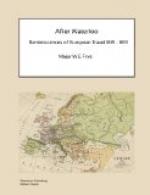We arrived a little before six at Terracina, which is on the banks of the Mediterranean and may be distinguished at a great distance by its white buildings. The chain of mountains on the left of our road hither form a sort of arch to the chord of the linea Pia and terminates one end of the arch by meeting the linea Pia at Terracina, which forms what the sailors call a bluff point. Terracina stands on the situation of the ancient Anxur and the description of it by Horace in his Brundusian journey;
Impositum saxis late candentibus Anxur[94]
is perfectly applicable even now. It is a handsome looking city and is the last town in the Pope’s territory: part of it is situated on the mountain and part on the plain at its foot close to the sea.
The fine white buildings on the heights, the temple of Jupiter Anxurus (of which the facade and many columns remain entire) towering above them, the orange trees and the sea, afford a view doubly pleasing and grateful to the traveller after the dreary landscape of the Pontine Marshes. There is but one inn at Terracina but that is a very large one; there is, however, but very indifferent fare and bad attendance. The innkeeper is a sad over-reaching rascal, who fleeces in the most unmerciful manner the traveller who is not spesato. He is obliged to furnish those who are spesati with supper and lodging at the vetturino’s price; but he always grumbles at it, gives the worst supper he can and bestows it as if he were giving alms. As the road between Terracina and Fondi (the first Neapolitan town) is said to be at times infested by robbers, few travellers care to start till broad daylight. We did so accordingly the following morning. On arriving at a place called the Epitafio, from there being an ancient tomb there, we took leave of the last Roman post. At one mile and half beyond the Epitafio is the first Neapolitan post at a place called Torre de’ Confini, where we were detained half an hour to have our passports examined and our portmanteaus searched. Three miles beyond this post is the miserable and dirty town of Fondi, wherein our baggage again underwent a strict search. On leaving Terracina the road strikes inland and has mountains covered with wood to the right and to the left, nor do we behold the sea again till just before we arrive at Mola di Gaeta, which is an exceeding long straggling town on its banks; several fishing vessels lie here and it is here that part of the Bay of Naples begins to open. The country from Terracina to Fondi is uncultivated and very mountainous; between Fondi and Mola di Gaeta it is pretty well cultivated; Itri, thro’ which we passed, is a long, dirty, wretched looking village.
The next day at twelve o’clock we arrived and stopped to dine at St Agatha, a miserable village, with a very bad tho’ spacious inn the half of which is unroofed. We arrived at Capua the same evening having passed the rivers Garigliano and Volturno, and leaving the Falernian Hills on our left during part of the road. The landscape is very varied on this route, sometimes mountainous, sometimes thro’ a rich plain in full cultivation.




